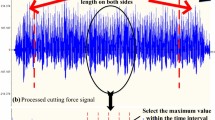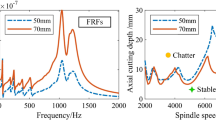Abstract
Milling force can generally be predicted from orthogonal cutting data. However, the accuracy of the predicted result is largely affected by the dynamic properties of the machine tool system, and a large number of repeated milling tests are required for the different types of machine tool to reduce the prediction error. A data-driven method, which could predict the cutting force of different machine tools through only a small number of tests, is proposed in this paper based on the transfer learning method. First, the cutting force coefficients are obtained through orthogonal cutting test. Then, the influence of the dynamic properties of the machine tool system is considered by introducing a correction coefficient to improve the conversion accuracy from orthogonal cutting to helical milling process. After obtaining the cutting force of the source machine tool with sufficient cutting data, the regional adaptive method combining with neural network is utilized to predict the cutting force of the target machine tool with only a small amount cutting data. Finally, a series of milling tests are carried out on different machine tools to verify the accuracy of the proposed method. The results indicate that the developed method can predict the milling force with a high accuracy.















Similar content being viewed by others
Data availability
All data generated or analyzed during this study are included in this published article.
References
Kyprianidis KG (2011) Future aero engine designs: an evolving vision. Intech Open
Bai J, Liu S, Wang W (2020) Progress in the airworthiness technology of civil aero-engine. CEAS Aeronaut J 11(1):1–12
Kiran K, Kayacan MC (2019) Cutting force modeling and accurate measurement in milling of flexible workpieces. Mech Syst Signal Pr 133:106284
Wang MH, Gao L, Zheng YH (2014) An examination of the fundamental mechanics of cutting force coefficients. Int J Mach Tools Manuf 78:1–7
Zhang Z, Li HG, Meng G, Ren S, Zhou JW (2017) A new procedure for the prediction of the cutting forces in peripheral milling. Int J Adv Manuf Tech 89:1709–1715
Altintas Y, Ber AA (2001) Manufacturing automation: metal cutting mechanics, machine tool vibrations, and CNC design. Appl Mech Rev 54(5):B84
Bhattacharyya A, Schueller JK, Mann BP, Ziegert JC, Schmitz TL, Taylor FJ, Fitz-Coy NG (2010) A closed form mechanistic cutting force model for helical peripheral milling of ductile metallic alloys. Int J Mach Tools Manuf 50(6):538–551
Gradišek J, Kalveram M, Weinert K (2004) Mechanistic identification of specific force coefficients for a general end mill. Int J Mach Tools Manuf 44(4):401–414
Wan M, Lu MS, Zhang WH, Yang Y (2012) A new ternary-mechanism model for the prediction of cutting forces in flat end milling. Int J Mach Tools Manuf 57:34–45
Ozturk E, Ozkirimli O, Gibbons T, Saibi M, Turner S (2016) Prediction of effect of helix angle on cutting force coefficients for design of new tools. CIRP Ann 65(1):125–128
Wan M, Feng J, Zhang WH, Yang Y, Ma YC (2017) Working mechanism of helix angle on peak cutting forces together with its design theory for peripheral milling tools. J Mater Process Technol 249:570–580
Li ZP, Yan R, Tang XW, Peng FY, Xin SH, Wu JW (2021) Analysis of the effect of tool posture on stability considering the nonlinear dynamic cutting force coefficient. J Manuf Sci Eng Trans ASME 143(8):081009
Yao ZQ, Liang XG, Luo L, Hu J (2013) A chatter free calibration method for determining cutter runout and cutting force coefficients in ball-end milling. J Mater Process Technol 213(9):1575–1587
Sun YJ, Sun J, Li JF, Li WD, Feng B (2013) Modeling of cutting force under the tool flank wear effect in end milling Ti6Al4V with solid carbide tool. Int J Adv Manuf Technol 69:2545–2553
Wang Q, Zhang DH, Tang K, Zhang Y (2019) A mechanics based prediction model for tool wear and power consumption in drilling operations and its applications. J Clean Prod 234:171–184
Budak E, Altintas Y, Armarego EJA (1996) Prediction of milling force coefficients from orthogonal cutting data. J Manuf Sci Eng Trans ASME 118(2):216–224
Gonzalo O, Beristain J, Jauregi H, Sanz C (2010) A method for the identification of the specific force coefficients for mechanistic milling simulation. Int J Mach Tools Manuf 50(9):765–774
Lin B, Wang L, Guo Y, Yao JM (2016) Modeling of cutting forces in end milling based on oblique cutting analysis. Int J Adv Manuf Technol 84:727–736
Chen X, Zhang DH, Wang Q (2021) Cutting force transition model considering the influence of tool system by using standard test table. Sensors 21(4):1340
Grossi N, Sallese L, Scippa A, Campatelli G (2015) Speed-varying cutting force coefficient identification in milling. Precis Eng 42:321–334
Cao Y, Altintas Y (2007) Modeling of spindle-bearing and machine tool systems for virtual simulation of milling operations. Int J Mach Tools Manuf 47(9):1342–1350
Funding
This study is supported by the National Natural Science Foundation of China (No. 52005413) and the Fundamental Research Funds for the Central Universities (Grant No. 3102021bzb004) and the Fundamental Research Funds for the Central Universities (No.D5000220135).
Author information
Authors and Affiliations
Contributions
Xi Chen wrote the paper and carried out the experiments; Zhao Zhang designed the framework of the paper and provided data analysis; Dinghua Zhang contributed to the main idea of the paper; Ming Luo provided the experimental condition; Qi Wang helped with the experiments.
Corresponding author
Ethics declarations
Ethics approval
Not applicable.
Consent to participate
Not applicable.
Consent for publication
All authors have read and agreed to the published version of the paper.
Conflict of interest
The authors declare no competing interests.
Additional information
Publisher's Note
Springer Nature remains neutral with regard to jurisdictional claims in published maps and institutional affiliations.
Rights and permissions
About this article
Cite this article
Chen, X., Zhang, Z., Wang, Q. et al. Cutting force prediction between different machine tool systems based on transfer learning method. Int J Adv Manuf Technol 121, 619–631 (2022). https://doi.org/10.1007/s00170-022-09316-8
Received:
Accepted:
Published:
Issue Date:
DOI: https://doi.org/10.1007/s00170-022-09316-8




